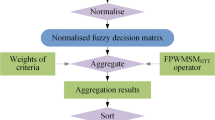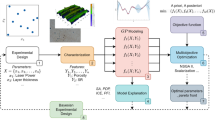Abstract
The additive manufacturing industry requires effective and standardized methods for selecting design variants generated through computational tools. To address this need and overcome the current barriers in the industry, a decision support system based on quantitative metrics is necessary. This research aims to establish multiple criteria for evaluating design variations in additive manufacturing, considering both opportunistic and constraint-based approaches. The multi-criterion decision-making process integrates four distinct metrics that capture aspects such as geometric complexity, cost–benefit, and the additional cost associated with support structures. To facilitate the evaluation of design variants in metal additive manufacturing using laser powder bed fusion, a fuzzy power Maclaurin symmetric mean operator is employed for metric aggregation. The proposed approach is demonstrated by assessing topologically optimized design variants of an airplane bearing bracket and an engine bracket. The ranking and selection of design variants using this approach resulted in significant cost reductions, with a 50% reduction for the airplane bracket and a 75% reduction for the engine bracket, compared to the original designs manufactured using additive manufacturing techniques.













Similar content being viewed by others
Abbreviations
- \(c_{\mathit e\mathit s}\) :
-
External shape complexity metric
- \(c_{\mathit i\mathit s}\) :
-
Internal structure complexity metric
- \(C_{After\mathit\;TO}\) :
-
Processing cost in AM after optimization \((USD)\)
- \(C_{Before\mathit\;TO}\) :
-
Processing cost in AM before optimization \((USD)\)
- \(C_{\mathit b\mathit r}\) :
-
Cost benefit ratio
- \(C_{\mathit i}\) :
-
Incremental cost \((USD)\)
- \({\mathit{(C_S)}}_{\mathit A\mathit f\mathit t\mathit e\mathit r\mathit\;\mathit T\mathit O}\) :
-
Processing cost of support structure after optimization (\(USD\))
- \({\mathit{(C_S)}}_{\mathit B\mathit e\mathit f\mathit o\mathit r\mathit e\mathit\;\mathit T\mathit O}\) :
-
Processing cost of support structure before optimization (\(USD\))
- \(y_{\mathit i\mathit,\mathit j}\) :
-
Value of each criterion in the decision matrix
References
Gibson I, Rosen D, Stucker B, Khorasani M (2021) Additive manufacturing technologies. Springer International Publishing, Cham
Duda T, Raghavan LV (2018) 3D metal printing technology: the need to re-invent design practice. AI Soc 33:241–252. https://doi.org/10.1007/s00146-018-0809-9
Ben Amor S, Tahan A, Louhichi B (2022) The impact of geometric complexity on printing time and cost for additive manufacturing (AM) process. In: Bouraoui T, Benameur T, Mezlini S et al (eds) Lecture Notes in Mechanical Engineering. Springer International Publishing, Cham, pp 203–210
Kirchheim A, Dennig H, Zumofen L (2018) Industrializing additive manufacturing - proceedings of additive manufacturing in products and applications - AMPA2017. Ind Addit Manuf - Proc Addit Manuf Prod Appl - AMPA2017. https://doi.org/10.1007/978-3-319-66866-6
Wiberg A, Persson J, Ölvander J (2021) An optimisation framework for designs for additive manufacturing combining design, manufacturing and post-processing. Rapid Prototyp J 27:90–105. https://doi.org/10.1108/RPJ-02-2021-0041
Yao X, Moon SK, Bi G (2017) Multidisciplinary design optimization to identify additive manufacturing resources in customized product development. J Comput Des Eng 4:131–142. https://doi.org/10.1016/j.jcde.2016.10.001
Liu G, Xiong Y, Rosen DW (2022) Multidisciplinary design optimization in design for additive manufacturing. J Comput Des Eng 9:128–143. https://doi.org/10.1093/jcde/qwab073
Lindemann C, Reiher T, Jahnke U, Koch R (2015) Towards a sustainable and economic selection of part candidates for additive manufacturing. Rapid Prototyp J 21:216–227. https://doi.org/10.1108/RPJ-12-2014-0179
Page TD, Yang S, Zhao YF (2019) Automated candidate detection for additive manufacturing: a framework proposal. Proc Des Soc Int Conf Eng Des 1:679–688. https://doi.org/10.1017/dsi.2019.72
Yao X, Moon SK, Bi G (2017) A hybrid machine learning approach for additive manufacturing design feature recommendation. Rapid Prototyp J 23:983–997. https://doi.org/10.1108/RPJ-03-2016-0041
Ahtiluoto M, Ellman AU, Coatanea E (2019) Model for evaluating additive manufacturing feasibility in end-use production. Proc Int Conf Eng Des 1:799–808. https://doi.org/10.1017/dsi.2019.84
Parks T, Kaplan BJ, Pokorny LR et al (2016) Additive manufacturing: which DLA-managed legacy parts are potential AM candidates? Report No. DL501T1. https://apps.dtic.mil/sti/pdfs/AD1013934.pdf
Klahn C, Fontana F, Leutenecker-Twelsiek B, Meboldt M (2020) Mapping value clusters of additive manufacturing on design strategies to support part identification and selection. Rapid Prototyp J 26:1797–1807. https://doi.org/10.1108/RPJ-10-2019-0272
Jee H, Lu Y, Witherell P (2020) Design rules with modularity for additive manufacturing. Proc - 26th Annu Int Solid Free Fabr Symp - An Addit Manuf Conf SFF 2015 59:1450–1462
Schneck M, Gollnau M, Lutter-Günther M et al (2019) Evaluating the use of additive manufacturing in industry applications. Procedia CIRP 81:19–23. https://doi.org/10.1016/j.procir.2019.03.004
Ghiasian SE, Jaiswal P, Rai R, Lewis K (2018) From conventional to additive manufacturing: determining component fabrication feasibility. In: International Design Engineering Technical Conferences and Computers and Information in Engineering Conference. American Society of Mechanical Engineers 51753:V02AT03A043. https://doi.org/10.1115/DETC2018-86238
Pham D, Gault R (1998) A comparison of rapid prototyping technologies. Int J Mach Tools Manuf 38:1257–1287. https://doi.org/10.1016/S0890-6955(97)00137-5
Bibb R (1999) The development of a rapid prototyping selection system for small companies. Doctoral dissertation, Cardiff Metropolitan University
Campbell RI, Bernie MRN (1996) Creating a database of rapid prototyping system capabilities. J Mater Process Technol 61:163–167. https://doi.org/10.1016/0924-0136(96)02481-8
Pietor Vos (2014) 5 parameters that decide the success of your 3D printing project. http://3dprintbarometer.com/detail.html. Accessed 11 Nov 2023
Qin Y, Qi Q, Shi P et al (2023) Multi-attribute decision-making methods in additive manufacturing: the state of the art. Processes 11:497
Knofius N, van der Heijden MC, Zijm WHM (2016) Selecting parts for additive manufacturing in service logistics. J Manuf Technol Manag 27:915–931. https://doi.org/10.1108/JMTM-02-2016-0025
Foshammer J, Søberg PV, Helo P, Ituarte IF (2022) Identification of aftermarket and legacy parts suitable for additive manufacturing: a knowledge management-based approach. Int J Prod Econ 253:108573. https://doi.org/10.1016/j.ijpe.2022.108573
Muvunzi R, Mpofu K, Daniyan I (2021) An evaluation model for selecting part candidates for additive manufacturing in the transport sector. Metals 11:765. https://doi.org/10.3390/met11050765
Rochman DD, Anwar A, Margana R (2020) 3D print Covid-19 mask design selection using analytical hierarchy process. Solid State Technol 63:3127–3136
Dalpadulo E, Gherardini F, Pini F, Leali F (2020) Integration of topology optimisation and design variants selection for additive manufacturing-based systematic product redesign. Appl Sci 10:1–13. https://doi.org/10.3390/app10217841
Prabhu R, Masia JS, Berthel JT et al (2021) Maximizing design potential: investigating the effects of utilizing opportunistic and restrictive design for additive manufacturing in rapid response solutions. Rapid Prototyp J 27:1161–1171. https://doi.org/10.1108/RPJ-11-2020-0297
Booth JW, Alperovich J, Chawla P et al (2017) The design for additive manufacturing worksheet. J Mech Des Trans ASME 139:1–9. https://doi.org/10.1115/1.4037251
Bracken J, Pomorski T, Armstrong C et al (2020) Design for metal powder bed fusion: the geometry for additive part selection (GAPS) worksheet. Addit Manuf 35:101163. https://doi.org/10.1016/j.addma.2020.101163
Ahtiluoto M, Ellman AU, Coatanea E (2019) Model for evaluating additive manufacturing feasibility in end-use production. Proc Des Soc Int Conf Eng Des 1:799–808. https://doi.org/10.1017/dsi.2019.84
Zhang Y, Bernard A, Gupta RK, Harik R (2014) Evaluating the design for additive manufacturing: a process planning perspective. Procedia CIRP 21:144–150. https://doi.org/10.1016/j.procir.2014.03.179
Bibb R, Taha Z, Brown R, Wright D (1999) Development of a rapid prototyping design advice system. J Intell Manuf 10:331–339. https://doi.org/10.1023/a:1008920512663
Jayapal J, Kumaraguru S, Varadarajan S (2022) A view similarity-based shape complexity metric to guide part selection for additive manufacturing. Rapid Prototyp J ahead-of-p. https://doi.org/10.1108/RPJ-04-2022-0122
Barclift M, Joshi S, Simpson T, Dickman C (2016) Cost modeling and depreciation for reused powder feedstocks in powder bed fusion additive manufacturing. Solid Free Fabr 2016 Proc 27th Annu Int Solid Free Fabr Symp - An Addit Manuf Conf SFF 2016 2007–2028
Simpson TW (2021) Balancing MfAM and DfAM for metal additive manufacturing. In: Mod. Mach. Shop Online. https://www.mmsonline.com/articles/putting-dfam-and-mfam-to-work-for-a-metal-am-part-2. Accessed 25 Oct 2022
Bartsch K, Emmelmann C (2022) Enabling cost-based support structure optimization in laser powder bed fusion of metals. Jom 74:1126–1135. https://doi.org/10.1007/s11837-021-05055-5
(2016) 3yourmind. In: Addit. Manuf. Part Identifier. https://www.3yourmind.com/software-suite. Accessed 25 Oct 2022
Huang M, Chen L, Zhong Y, Qin Y (2021) A generic method for multi-criterion decision-making problems in design for additive manufacturing. Int J Adv Manuf Technol 115:2083–2095. https://doi.org/10.1007/s00170-021-06832-x
Qin Y, Qi Q, Shi P et al (2021) Automatic determination of part build orientation for laser powder bed fusion. Virtual Phys Prototyp 16:29–49. https://doi.org/10.1080/17452759.2020.1832793
(2013) GE jet engine bracket challenge. https://grabcad.com/challenges/ge-jet-engine-bracket-challenge
(2016) GRABCAD design community, Airplane Bearing Bracket Challenge. https://grabcad.com/challenges/airplane-bearing-bracket-challenge/entries. Accessed 25 Oct 2022
Brauers WKM, Zavadskas EK, Peldschus F, Turskis Z (2008) Multi-objective decision-making for road design. Transport 23:183–193. https://doi.org/10.3846/1648-4142.2008.23.183-193
Odu GO (2019) Weighting methods for multi-criteria decision making technique. J Appl Sci Environ Manag 23:1449. https://doi.org/10.4314/jasem.v23i8.7
Uzun B, Taiwo M, Syidanova A, Uzun Ozsahin D (2021) The Technique For Order of Preference by Similarity to Ideal Solution (TOPSIS). In: Uzun B, LaMoreaux J (eds) Uzun Ozsahin D, Gökçeku\cs H. Application of multi-criteria decision analysis in environmental and civil engineering. Springer International Publishing, Cham, pp 25–30
Rajput V, Sahu NK, Agrawal A (2022) Integrated AHP-TOPSIS methods for optimization of epoxy composite filled with Kota stone dust. Mater Today Proc 50:2371–2375. https://doi.org/10.1016/j.matpr.2021.10.251
Baydaş M (2022) Comparison of the performances of MCDM methods under uncertainty: an analysis on Bist SME industry index. OPUS J Soc Res 19:1–1. https://doi.org/10.26466/opusjsr.1064280
Author information
Authors and Affiliations
Contributions
All authors contributed to the study conception and design. Material preparation, data collection, and analysis were performed by JJ and SK. The first draft of the manuscript was written by JJ, and all authors commented on previous versions of the manuscript. All authors read and approved the final manuscript.
Corresponding author
Ethics declarations
Competing interests
The authors declare no competing interests.
Additional information
Publisher's Note
Springer Nature remains neutral with regard to jurisdictional claims in published maps and institutional affiliations.
Electronic supplementary material
Below is the link to the electronic supplementary material.
Appendix
Rights and permissions
Springer Nature or its licensor (e.g. a society or other partner) holds exclusive rights to this article under a publishing agreement with the author(s) or other rightsholder(s); author self-archiving of the accepted manuscript version of this article is solely governed by the terms of such publishing agreement and applicable law.
About this article
Cite this article
Jayapal, J., Kumaraguru, S. & Varadarajan, S. Evaluation of computationally optimized design variants for additive manufacturing using a fuzzy multi-criterion decision-making approach. Int J Adv Manuf Technol 129, 5199–5218 (2023). https://doi.org/10.1007/s00170-023-12641-1
Received:
Accepted:
Published:
Issue Date:
DOI: https://doi.org/10.1007/s00170-023-12641-1




